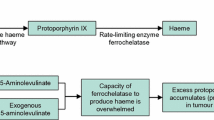Abstract
Purpose
To assess the impact of hexaminolevulinate (HAL) on the long-term recurrence rate of NMIBC.
Methods
A total of 130 patients with bladder tumour were randomized into two groups. The patients in one group had a HAL instillation before surgery, and they first had a white-light and after that a blue-light cystoscopy (BL group) and resection. The second group had only white-light cystoscopy (WL group) and resection. They have been followed up with cystoscopy every 3 months for a period of up to 40 months.
Results
The recurrence-free period was not significantly different between the two groups (BL and WL groups) (long-rank test p = 0.202). The use of HAL helped detect four flat lesions and 28 papillary lesions with cancer that would have been missed under WL only, on 16 out of the 54 patients (29.6 % CI 95 % 11.1–33.3). The use of HAL changed the proposed postoperative treatment and follow-up for one out of the five patients.
Conclusions
Although the use of HAL cystoscopy identified at least one cancer lesion more than WL cystoscopy on one out of the three patients, the recurrence-free period was not significantly different.


Similar content being viewed by others
References
Sylvester RJ, van der Meijden AP, Oosterlinck W, Witjes JA, Bouffioux C, Denis L, Newling DW, Kurth K (2006) Predicting recurrence and progression in individual patients with stage Ta T1 bladder cancer using EORTC risk tables: a combined analysis of 2596 patients from seven EORTC trials. European urology 49 (3):466–465; discussion 475–467
Grossman HB, Gomella L, Fradet Y, Morales A, Presti J, Ritenour C, Nseyo U, Droller MJ (2007) A phase III, multicenter comparison of hexaminolevulinate fluorescence cystoscopy and white light cystoscopy for the detection of superficial papillary lesions in patients with bladder cancer. J Urol 178(1):62–67
Jocham D, Witjes F, Wagner S, Zeylemaker B, van Moorselaar J, Grimm MO, Muschter R, Popken G, Konig F, Knuchel R, Kurth KH (2005) Improved detection and treatment of bladder cancer using hexaminolevulinate imaging: a prospective, phase III multicenter study. The Journal of urology 174 (3):862–866; discussion 866
Mostafid H, Bunce C (2009) Improved detection and reduced early recurrence of non-muscle-invasive bladder cancer using hexaminolaevulinate fluorescence cystoscopy: results of a multicentre prospective randomized study (PC B305). BJU Int 104(7):889–890
Stenzl A, Burger M, Fradet Y, Mynderse LA, Soloway MS, Witjes JA, Kriegmair M, Karl A, Shen Y, Grossman HB (2010) Hexaminolevulinate guided fluorescence cystoscopy reduces recurrence in patients with nonmuscle invasive bladder cancer. J Urol 184(5):1907–1913. doi:10.1016/j.juro.2010.06.148
Hermann GG, Mogensen K, Carlsson S, Marcussen N, Duun S (2011) Fluorescence-guided transurethral resection of bladder tumours reduces bladder tumour recurrence due to less residual tumour tissue in Ta/T1 patients: a randomized two-centre study. BJU Int 108(8 Pt 2):E297–E303. doi:10.1111/j.1464-410X.2011.10090.x
Geavlete B, Multescu R, Georgescu D, Jecu M, Stanescu F, Geavlete P (2012) Treatment changes and long-term recurrence rates after hexaminolevulinate (HAL) fluorescence cystoscopy: does it really make a difference in patients with non-muscle-invasive bladder cancer (NMIBC)? BJU Int 109(4):549–556. doi:10.1111/j.1464-410X.2011.10374.x
Witjes JA, Redorta JP, Jacqmin D, Sofras F, Malmstrom PU, Riedl C, Jocham D, Conti G, Montorsi F, Arentsen HC, Zaak D, Mostafid AH, Babjuk M (2010) Hexaminolevulinate-guided fluorescence cystoscopy in the diagnosis and follow-up of patients with non-muscle-invasive bladder cancer: review of the evidence and recommendations. Eur Urol 57(4):607–614. doi:10.1016/j.eururo.2010.01.025
European Association of Urology, Pocket Guidelines (2012)
Ibrahim JG, Chen, M. H., and Sinha, D (2001) Bayesian Survival Analysis
Schumacher MC, Holmang S, Davidsson T, Friedrich B, Pedersen J, Wiklund NP (2010) Transurethral resection of non-muscle-invasive bladder transitional cell cancers with or without 5-aminolevulinic Acid under visible and fluorescent light: results of a prospective, randomised, multicentre study. Eur Urol 57(2):293–299. doi:10.1016/j.eururo.2009.10.030
Filbeck T, Roessler W, Knuechel R, Straub M, Kiel HJ, Wieland WF (1999) 5-aminolevulinic acid-induced fluorescence endoscopy applied at secondary transurethral resection after conventional resection of primary superficial bladder tumors. Urology 53(1):77–81
Grimbergen MC, van Swol CF, Jonges TG, Boon TA, van Moorselaar RJ (2003) Reduced specificity of 5-ALA induced fluorescence in photodynamic diagnosis of transitional cell carcinoma after previous intravesical therapy. Eur Urol 44(1):51–56
Hendricksen K, Moonen PM, der Heijden AG, Witjes JA (2006) False-positive lesions detected by fluorescence cystoscopy: any association with p53 and p16 expression? World J Urol 24(5):597–601. doi:10.1007/s00345-006-0109-8
Obermann EC, Junker K, Stoehr R, Dietmaier W, Zaak D, Schubert J, Hofstaedter F, Knuechel R, Hartmann A (2003) Frequent genetic alterations in flat urothelial hyperplasias and concomitant papillary bladder cancer as detected by CGH, LOH, and FISH analyses. J Pathol 199(1):50–57. doi:10.1002/path.1259
Acknowledgments
The authors wish to thank Stavros A. Chatzopoulos, Adjunct Lecturer, Department of Mathematics of Aristotle University of Thessaloniki, for the statistical analysis of the study.
Conflict of interest
The authors declare that they have no conflict of interest.
Author information
Authors and Affiliations
Corresponding author
Rights and permissions
About this article
Cite this article
Gkritsios, P., Hatzimouratidis, K., Kazantzidis, S. et al. Hexaminolevulinate-guided transurethral resection of non-muscle-invasive bladder cancer does not reduce the recurrence rates after a 2-year follow-up: a prospective randomized trial. Int Urol Nephrol 46, 927–933 (2014). https://doi.org/10.1007/s11255-013-0603-z
Received:
Accepted:
Published:
Issue Date:
DOI: https://doi.org/10.1007/s11255-013-0603-z




